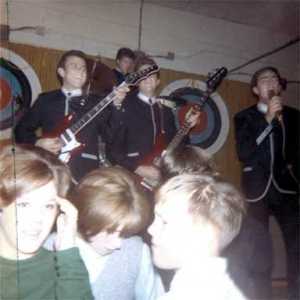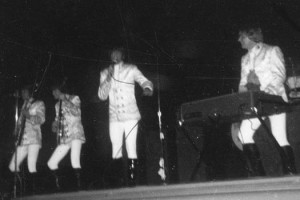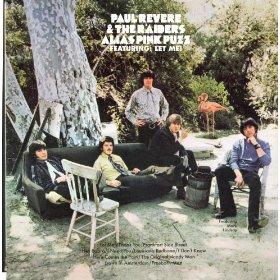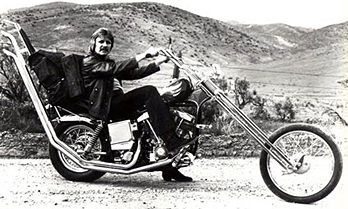Diane is a former disc jockey who writes books filled with quirky characters who spend too much time in Warped Records, a fictional music store. Her premises are driven by real-life events in rock history or contain characters inspired by those that once graced the top of the charts. Grab a copy of Scary Modsters, Voices Carry, or Moonlight Serenade and play “spot the references” with her.
Paul Revere & The Raiders: America’s Answer To The British Invasion
- They were the first rock group signed to Columbia Records.
- The group has sold nearly 50 million records over the course of their career.
- They had 15 consecutive hit singles, 6 of which were top 10.
- From their inception through their peak years of fame (1961 to 1972), they recorded 15 studio albums and released 3 greatest hits packages. Many of those albums went gold.
- In the first four months of 1967, they received four gold records for the albums Here They Come, Just Like Us!, Midnight Ride, and The Spirit of ‘67. Not even The Beatles can match that.
- Their second major national hit, “Just Like Me” (1965 – #11) was one of the first rock records to feature a distinctive, double-tracked guitar solo (by guitarist Drake Levin).
- “Kicks” (1966) ranked #400 on Rolling Stone magazine’s list of The 500 Greatest Songs of All Time.
- The Raiders appeared on 520 episodes of Where the Action Is on ABC. After that, they were the hosts of It’s Happening (a.k.a Happening ’68 and Happening ’69), also on ABC. Meanwhile, they appeared on numerous other TV shows including Ed Sullivan, The Smothers Brothers, Hollywood Palace, and Batman, giving the Raiders over 720 network appearances and making them the most televised musical group in the world.
- In the summer of 1971, The Raider’s recording of “Indian Reservation” sold nearly 4 million copies, making it the biggest selling record for Columbia in 10 years.
- Paul Revere and The Raiders have withstood the test of time and various incarnations. Their stamina and longevity have proven they are one of the greatest American rock and roll bands of all time.
THE EARLY YEARS |
The history of Paul Revere and the Raiders is a long and sometimes complicated one. While this overview may not appear to be brief, it really is a quick summary of the incredible history of this amazing band.
Paul Revere’s parents were victims of the Great Depression and moved to Idaho from Nebraska to obtain free homesteading. They lived on a farm that was incapable of producing crops and did not have an indoor bathroom. When Paul inherited $500 from a long-lost relative, he decided to go into business for himself and opened a barbershop. Eventually he turned one shop into two, and then went on to open a small chain. Shortly thereafter, he opened his own diner, the Reed and Bell, where his band, The Downbeats, played regularly.
It was at the Reed and Bell where Paul met bun delivery boy Mark Lindsay, whom he brought into The Downbeats. The crowds quickly began to grow, and before Paul knew it, he was clearing $600 a night, which was a substantial amount of money in Idaho at the beginning of the 1960s. The Downbeats were becoming huge within their region and decided to record a single. At the urging of the record label’s owner, The Downbeats became Paul Revere and the Raiders. “Beatnik Sticks” was then released, followed by the album Like, Long Hair.
Just as things were taking off, Paul was drafted. His conscientious objector status placed him working as a cook in a mental institution in Portland for two years. Meanwhile, Mark Lindsay went to Hollywood where the biggest chunk of success he had was as the wine bottle clinker on the Hollywood Argyle’s “Alley Oop”.
When Paul finished with his service at the mental hospital, he and Mark reformed Paul Revere and the Raiders. It was at this time that they became known for their outrageous on-stage antics and gained a reputation for being rowdy by jumping on speakers, climbing into rafters, and breaking a piano every night on stage. It was during this time that Paul met Portland disc jockey Roger Hart, who became the band’s manager and helped them release the Lp Paul Revere and the Raiderson their own Sande label.
And then along came “a thing called Louie, Louie.”
LOUIE AND DICK CLARK |
The debate over if the Raiders or the Kingsmen recorded “Louie, Louie” first has been a hot subject for decades. Some members of The Raiders say it was them, while others claim it was The Kingsmen. The story the Kingsmen tell is similar. It is known that both bands recorded that same song, in the same studio, within a few days of each other. The short version of the remaining story is that, possibly due to Columbia’s negligence in marketing, the Raiders had a big regional hit with “Louie, Louie” selling over 15,000 copies in Portland alone, while the Kingsmen took their version national. (For more information about The Raiders vs. The Kingsmen, the recording of the song, and the marketing involved, read Dave Marsh’s book Louie, Louieavailable from Hyperion.)
Around this time, Paul happened to walk pass a costume shop in Portland. While seeking some gag items to pull on the band while on stage, he discovered what he came to refer to as “the idiot costumes”. After intermission at one of their shows, the band pulled a gag on the audience and appeared in what became their signature Colonial uniforms. The costumes brought about so much fun that The Raiders went on to rent them for all of their gigs.
When Dick Clark brought his Caravan of Stars to Salem, Oregon, he had a hard time getting an audience. Upon hearing that the local youth were at another show across town, he sent his representatives to see what was going on. Dick got reports of a wildly visual band that was just about literally tearing down the house. Dick decided to put The Raiders on a new TV show called Where the Action Is, and the popularity of The Raiders skyrocketed. But while the idiot costumes and the TV show made them famous, if they wanted to be an on going success, it would take a lot more to keep them in the public eye.
Fortunately, their talent won out over the potential of being a flash in a glittery pan. Columbia signed Paul Revere and the Raiders as their first rock band, and a string of hits followed. In 1965, Paul Revere and the Raiders, who were dubbed America’s Answer to the British Invasion, were a force to be reckoned with—and not just in the teen idol money machine way either. Their second national hit, “Just Like Me” (1965 – #11) was one of the first rock records to feature a distinctive, double-tracked guitar solo, which was done by Drake Levin. When looking back on those early hits from today’s perspective, it is clear how the music of The Raiders and other Northwest bands of the time were heavily influential on the Northwest grunge sound of the 1990s. In the mid-60s, music was changing from the passive (such as folk) to the wild (garage rock). With songs like “Kicks”, “Hungry”, and “Just Like Me”, Paul Revere and the Raiders were obviously a large part of the movement.
In the first four months of 1967, The Raiders received four gold records for the albums, Here They Come!, Just Like Us!, Midnight Ride, and The Spirit of ’67. They had made over 500 television appearances and had numerous hit singles. By the end of 1967, the Raiders had struck gold several times over, both in the recording business and on television.
Meanwhile, Drake Levin had been drafted and was replaced by Jim Valley and then later by Freddie Weller. Phil Volk and Mike Smith also parted ways with Paul Revere and the Raiders and eventually formed The Brotherhood with Levin. Volk was then replaced by Charlie Coe, a former Raider from the early days, and Smith was replaced by Joe Correro, Jr. Although they kept the Colonial uniforms, the costumes became more glittery and showman like. The band’s sound started changing direction too, thanks to Weller and Correro’s southern roots. Paul insisted to Columbia that Mark take over as producer, which makes Paul Revere and the Raiders one of the first rock acts to be self-produced. Lastly, Paul Revere and the Raiders starred in two more TV series, the daily It’s Happening, and a weekend version of the show called Happening ’68 (which later appropriately became Happening ’69.)
POST ACTION |
The Revere, Lindsay, Weller, Coe, and Correro version of the group released four albums together (Revolution! [Which was actually recorded with the previous line up.], A Christmas Present … and Past, Goin’ to Memphis, andSomething Happening) before Charlie Coe left the band. Former Where The Action Is star and long-time friend Keith Allison replaced Coe.
After the fairly disappointing release of Hard n’ Heavy (with Marshmallow),the band felt it obvious that they were not being taken seriously; thus, the costumes needed to go. Lindsay told Hit Parader Magazine that in an effort to prove the band’s quirkiness was the problem and not their music, they slipped the Los Angeles underground rock stations advance copies of an album by a hot new group called Pink Puzz. The tracks received a lot of favorable attention until the disk jockeys learned that Pink Puzz was really Paul Revere and the Raiders and stopped playing the tracks. Alias Pink Puzzwas later released by the band and got less than desired results. Meanwhile, the HappeningTV shows ended and all looked bleak.
Deciding to hit back harder then ever, the band (now known simply as The Raiders), along with producer John d’Andrea and a group of hot session artists, produced the critically acclaimed Collage. Mark had set out to create sounds like no other band had. One example of his success is the song “Dr. Fine”, whose “rubber” sounding drums were created by an effect called tape slap. (Tape slap is a delay effect that is created when you monitor off of the playback and the record heads of two machines simultaneously. The distance of these two heads and the speed at which the tape goes through them cause the delay.) But Mark wanted something faster and more interesting than the 30 inches per second that the studio’s machines had to offer. As a result, he had the engineers run the tape through the studio and crank up the voltage on the tape machines. In order to get the desired effects, he did this with multiple sets of machines running at different speeds, some of them approaching 100 inches of tape per second. Mark’s system became so complicated that he eventually had tie lines running from three other studios into the one in which he was mixing. The giant load on the electrical system actually blew the circuit breakers a few times, heralding the arrival of the CBS Chief Maintenance Engineer, who ran into the studio while screaming caustic comments about rock and roll producers and their asinine experiments.
Rolling Stone critic Lenny Kaye commented about Collage, “…This is a great album from the moment it takes off” and went on to say “Mark Lindsay never fails to give the impression that he knows what he’s doing. Almost single-handedly, he’s brought The Raiders to a stronger position than they’ve occupied in years.” However, despite its brilliance, Collage went mostly unheard, and its single, “Just Seventeen” peaked at a mere #70 on the charts.
The Raiders seemed to disappear after Collage, but a year later they suddenly found themselves with not only a huge hit record, but also their first #1 single, “Indian Reservation”.
“Indian Reservation” became a hit solely because of Paul Revere’s drive. In an unprecedented move, Paul and his friend, Mike Allen, drove their motorcycles cross-country, while stopping off at Top 40 radio stations and convincing them to play “Indian Reservation”. The result was pure gold and the biggest hit ever for The Raiders. Suddenly they were back on TV, and while their shows were no longer performed in huge stadiums, The Raiders were again well known. However, their follow-up album, Country Wine, failed to gain the attention it deserved, and The Raiders once again faded.
Even with numerous personnel changes, Paul kept the band going through the 70s with the release of a few unsuccessful singles. However, the band played on, and on, and on. Fast-forward a decade, and by the early 80s, Paul Revere and the Raiders (featuring the line up of Omar Martinez, Doug Heath, Ron Foos, Danny Krause, and Carl Driggs—most of whom had already been with Paul for almost a decade), were America’s premiere show rock band. Although there have been a few changes since (Martinez was replaced by Matt Fasekas, and then by Tommy Scheckel. Driggs was replaced by Darrin Medley, and then by Darren Dowler.), these Raiders often played hundreds of times a year. Paul still ran the show with his unique and outrageous sense of humor that rivaled the best and most popular comics of our time.
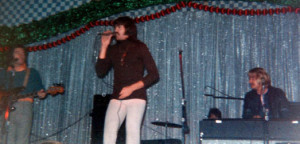
THE FUTURE |
We have now lost our Uncle Paul, and while our hearts bleed, we rejoice in knowing he has taken care of us by requesting the band live on. Paul Revere’s Raiders is comprised of the remaining members along with Paul’s son, Jamie, who had joined them off and on throughout the years. As much as I already miss Paul, I can’t wait to see what the future holds for these talented musicians in whom Paul had so much faith he insisted they rock on!
For a taste of why this band is so important to me, check out my post The Pain of Losing Paul Revere.
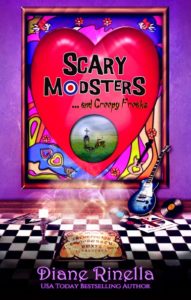 Diane’s love of The Raiders, along with other great bands of the era, shines through in the Romantic Comedy Scary Modsters … and Creepy Freaks, winner of the 2017 International Body, Mind, Spirit Award for Excellence in Visionary Fiction.
Diane’s love of The Raiders, along with other great bands of the era, shines through in the Romantic Comedy Scary Modsters … and Creepy Freaks, winner of the 2017 International Body, Mind, Spirit Award for Excellence in Visionary Fiction.







